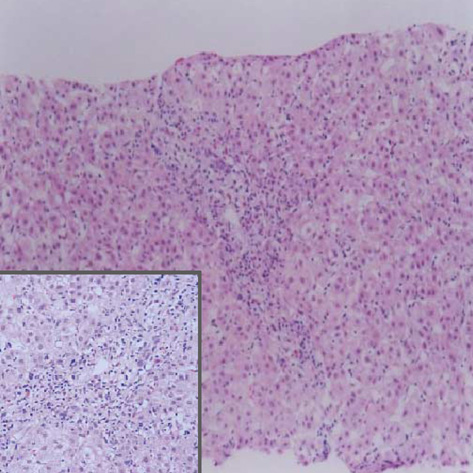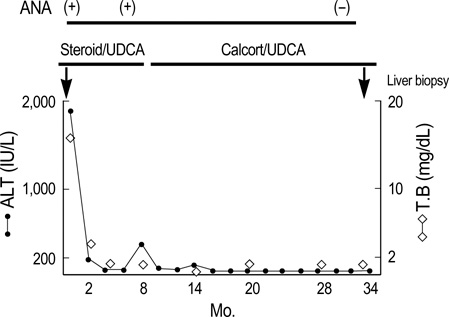J Korean Med Sci.
2006 Aug;21(4):758-760. 10.3346/jkms.2006.21.4.758.
Deflazacort for Type-1 Autoimmune Hepatitis in a Korean Girl
- Affiliations
-
- 1Department of Pediatrics, School of Medicine, Konkuk University, Seoul, Korea. baedori@hanafos.com
- 2Department of Pediatrics, Eul Ji Medical College, Seoul, Korea.
- 3Department of Pathology, Eul Ji Medical College, Seoul, Korea.
- KMID: 2157835
- DOI: http://doi.org/10.3346/jkms.2006.21.4.758
Abstract
- Prednisone or prednisolone are the mainstay drug treatments for autoimmune hepatitis in children. However, long-term use of corticosteroid is associated with the risk of steroid-induced toxicities, and this situation requires newer immuno-suppressive agents for the treatment of autoimmune hepatitis, especially in growing children. An 11-yr-old Korean girl with type-1 autoimmune hepatitis discontinued prednisolone due to toxicities, i.e., hirsutism, buffalo hump, and skin striae, and remained clinical and biochemical remission under replacement of deflazacort and ursodeoxycholic acid combination therapy. A follow-up liver biopsy after 19 months of deflazacort and ursodeoxycholic acid treatment showed histologic remission.
Keyword
MeSH Terms
Figure
Reference
-
1. Alvarez F. Suchy FJ, Sokol RJ, Balistreri WF, editors. Autoimmune hepatitis. Liver disease in children. 2001. 2nd ed. Philadelphia Lippincott: Williams & Wilkins;429–441.2. Gregorio GV, Portmann B, Reid F, Donaldson PT, Doherty DG, McCartney M, Mowat AP, Vergani D, Mieli-Vergani G. Autoimmune hepatitis in childhood: A 20-year experience. Hepatology. 1997. 25:541–547.
Article3. Alvarez F, Berg PA, Bianchi FB, Bianchi L, Burroughs AK, Cancado EL, Chapman RW, Cooksley WG, Czaja AJ, Desmet VJ, Donaldson PT, Eddleston AL, Fainboim L, Heathcote J, Homberg JC, Hoofnagle JH, Kakumu S, Krawitt EL, Mackay IR, MacSween RN, Maddrey WC, Manns MP, McFarlane IG, Meyer zum Buschenfelde KH, Mieli-Vergani G, Nakanuma Y, Nishioka M, Penner E, Porta G, Portmann BC, Reed WD, Rodes J, Schalm SW, Scheuer PJ, Schrumpf E, Seki T, Toda G, Tsuji T, Tygstrup N, Vergani D, Zeniya M. International autoimmune hepatitis group report: review of criteria for diagnosis of autoimmune hepatitis. J Hepatol. 1999. 31:929–938.
Article4. Vergani D, Mieli-Vergani G. Walker WA, Goulet O, Kleinman RE, Sherman PM, Shneider BL, Sanderson IR, editors. Autoimmune disease. Pediatric gastrointestinal disease. 2004. 4th ed. Hamilton: BC Decker;1208–1218.5. Tage-Jensen U, Schlichting P, Thomsen HF, Hoybye G, Thomsen AC. Malignancies following long-term azathioprine treatment in chronic liver disease. A report from the Copenhagen study group for liver diseases. Liver. 1987. 7:81–83.6. Nakamura K, Yoneda M, Yokohama S, Tamori K, Sato Y, Aso K, Aoshima M, Hasegawa T, Makino I. Efficacy of ursodeoxycholic acid in Japanese patients with type 1 autoimmune hepatitis. J Gastroenterol Hepatol. 1998. 13:490–495.
Article7. Czaja AJ, Carpenter HA, Lindor KD. Ursodeoxycholic acid as adjunctive therapy for problematic type 1 autoimmune hepatitis: a randomized placebo-controlled treatment trial. Hepatology. 1999. 30:1381–1386.
Article8. Markham A, Bryson HM. Deflazacort. A review of its pharmacological properties and therapeutic efficacy. Drugs. 1995. 50:317–333.9. Ferraris JR, Pasqualini T, Legal S, Sorroche P, Galich AM, Pennisi P, Domene H, Jasper H. Effect of deflazacort versus methylprednisone on growth, body composition, lipid profile, and bone mass after renal transplantation. The deflazacort study group. Pediatr Nephrol. 2000. 14:682–688.10. Campbell C, Jacob P. Deflazacort for the treatment of Duchenne dystrophy: a systemic review. BMC Neurol. 2003. 3:7.
Article11. Rebollo Bernardez J, Cifuentes Mimoso C, Pinar Moreno A, Caunedo Alvarez A, Salas Herrero E, Jimenez-Saenz M, Herrerias Gutierrez J. Deflazacort for long-term maintenance of remission in type 1 autoimmune hepatitis. Rev Esp Enferm Dig. 1999. 91:630–638.12. Gregorio GV, McFarlane B, Bracken P, Vergani D, Mieli-Vergani G. Organ and non-organ specific autoantibody titers and IgG levels as markers of disease activity: a longitudinal study in childhood autoimmune liver disease. Autoimmunity. 2002. 35:515–519.
- Full Text Links
- Actions
-
Cited
- CITED
-
- Close
- Share
- Similar articles
-
- A Case of Type I Autoimmune Hepatitis in Children
- Cyclosporine Treatment in a Patient with Concurrent Autoimmune Urticaria and Autoimmune Hepatitis
- A Case of Overlap Syndromebetween Autoimmune Hepatitis and Primary Biliary Cirrhosis
- Two Pediatric Cases of Type 1 Autoimmune Hepatitis with Normal Immunoglobulin G Levels Presenting as Fulminant Hepatitis
- A Case of Lupus-Related Hepatitis Mimicking Autoimmune Hepatitis




